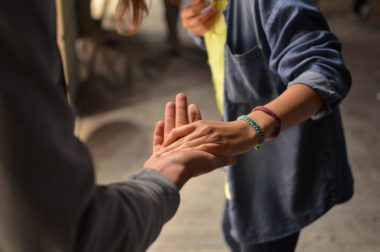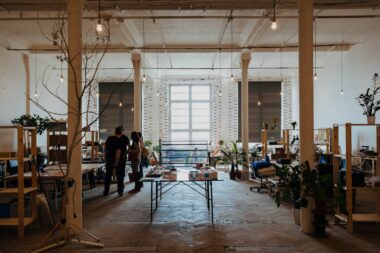Author: Markus Peschl, Oliver Lukitsch
List of Guiding Principle Articles
- Prelude: What Organizations Have in Common With Living Systems
- Principle #1: Radical Openness
- Principle #2: Sensing the Core
- Principle #3: Identifying and Bringing to Life Latent Potentials
- Principle #4: Designing and Co-creating
- Principle #5: Emergence
- Principle #6: Enabling
- Principle #7: Learning from the Future as it Emerges
This article is one of a series of blog posts in which we, the theLivingCore, present our fundamental guiding principles – and this time around, we introduce our third principle. We call it “designing and co-creating meaningful and desired realities”.
In a nutshell, our third principle sheds light on a key aspect of our understanding of innovation. It emphasizes that innovation is both (1) a design process and at the same time (2) a social process. In other words, innovation is about designing new realities and co-creating new meaning.
Innovation is an interplay between having a profound understanding of what is already there and designing something radically new and different. Hence, in order to innovate, one must first identify and understand already existing, latent future potentials, which then need to be cultivated and “brought into reality”. All this is set up as a process of co-creation that emerges in continuous interaction between the designer, users, stakeholders, and the object of innovation/change. In this way, innovation can create entirely new meaning (and realities) – and it can do so in a thriving and sustainable manner. Moreover, it will be accepted and understood by those who are affected by its appearance.
Understanding and making sense
Let’s go a little deeper and first look at our understanding of “design”, which is best reflected in the thinking and work of Klaus Krippendorff. It is well summarized in the following quote:
„The etymology of design goes back to the Latin de + signare and means making something, distinguishing it by a sign, giving it significance, designating its relation to other things, owners, users, or goods. Based on this original meaning, one could say: design is making sense (of things)… However, making sense always entails a bit of a paradox between the aim of making something new and different from what was there before, and the desire to have it make sense, to be recognizable and understandable. The former calls for innovation, while the latter calls for the reproduction of historical continuities.”
(Krippendorff, 1989, p. 9)
Hence, In order to bring forth novelty, we have to gain a deep understanding of the present. Paradoxically, this involves trajectories reaching from the past, revealing glimpses of the future. If we don’t, we risk creating something more or less arbitrary. Only a profound knowledge of our (present) object of interest will provide a firm basis for radical innovation.
So how can we strike this balance between present and future? How can we design novel, yet meaningful future realities?
Co-creating new meaning and realities
To answer the question just presented: We hold that (and conceive) radical innovation as a process of co-creation. True novelty emerges in continuous interaction and (co-)evolution between creative minds, the created artifact, and its potential users. It arises when minds engage with the (social and material) world and thus with other minds. Radical innovation happens when we co-create new meaning. On that account, innovation is a deeply social and physical engagement with the world around us. It is a “socio-epistemological process” that integrates “knowledge processes and social practices”. (And this does not contradict the idea that the very spark and source of new ideas originate from individual minds.)
By following this principle, one also ends up pursuing a radically human-centered approach to design (cf. Krippendorff 2007). Thereby, the user is not simply a passive object of interest, but rather a partner who serves as an expert for his/her own experience and life-world.
Most importantly, however, co-creation can involve a variety of different designers, users, stakeholders who together form a highly diverse system of collaborators. When a diverse group of people drives such knowledge processes, their interaction diversifies such knowledge processes too. And this opens up opportunities for new knowledge to emerge – and thus paves the way for radical innovation.
Understanding existing spaces of meaning
Notwithstanding their novel character, it is important that innovative products (and services) remain understandable. Hence, we need to ensure that external users will relate his/her present mental models or frames of reference and the novel artifact. Simply speaking, we need to build a bridge between the user’s established knowledge and a yet radically novel product/service.
The challenge for sustainable and thriving innovations, then, is not only to be simply new. Even if such innovations are to disrupt and can change the world around them, they must first respect the pre-existing context of possible users. They must be able to connect with their lifeworld. If this problem is solved in a balanced way, it has a major impact on how more radical innovation is accepted – or if it is accepted at all. It is thus decisive for an innovation to have a flourishing and sustainable impact on our economy and society.
At this point, we must also mention the MAYA principle. It states that we have to aim for designing the “most advanced, yet still acceptable” product/service. Our approach to design is a proven method for living up to the MAYA principle. It can be sustained by embedding design in pre-existing spaces of meaning and relevance, creating new meaning without losing touch with the present.
This is exactly why it is crucial to set up innovation as a co-creative process. It allows the designer not only to apply his/her own perspective/habits but rather to understand what the object of innovation means to users and various stakeholders: because to understand what is not quite there yet, we must first take seriously their experience and the spaces of meaning they inhabit. By that one establishes the basis for jointly exploring and realizing future potentials.
Elisabethinen: A brief study case
How does it look when our third principle (of designing and co-creating a meaningful and desired reality) is applied in practice?
One of our customers is the Order of the Sisters of St. Elizabeth. It’s an organization that breathes deeply human values, which are strongly embedded in their institution. Their values are not just statements but can be experienced in every encounter between people.
We were commissioned with designing a master plan for the re-development of the order’s entire urban premises in Vienna. In order to achieve this, we deployed a wide range of methods such as generative interviews, ethnographic observations, research, and most importantly, sense-making. All this allowed us to identify the future needs of older people and their caregivers to create a better place to live, work, heal, and co-exist in a deeply humane manner. Along the way, we involved a variety of different people, such as the elderly, nurses, physicians, care workers, and designers – and involved them all as experts of their own experience. We also immersed ourselves on-site, even using bodysuits to better understand the life of older people, their daily challenges, and needs. As a result, we designed the dining reception, wayfinding system, and reception area in surprisingly novel ways, all this without losing touch with the lifeworld of all the stakeholders affected.
The project at hand is the perfect example of how we include users and stakeholders in a co-creative manner. We consider this as essential for enable wide-ranging transformation, without losing touch of what is already there, hidden in the present.
If you’re interested, you can find more about the project on our “project page”.
Living our third principle
To conclude, the principle of designing and co-creating meaningful realities is ingrained into our own organizational DNA. We consider our innovation projects as knowledge-driven, interdisciplinary, multi-stakeholder projects in which designers, users, and crucial stakeholders jointly bring about desired futures. It goes without saying that our third principle is ingrained in our innovative technology leap. But it is just as much a guiding concept in our transformation technology Future Identity. And it also points the way forward when we create spaces for human-centered knowledge processes and learning, and thus spaces that enable co-creation. Just so that you know: we call them Enabling Spaces.
Image: Tim Mossholder at Unsplash
Subscribe to Our Newsletter
Keep your innovative edge with more stories like this and additional reading tips, muses, and project updates.


